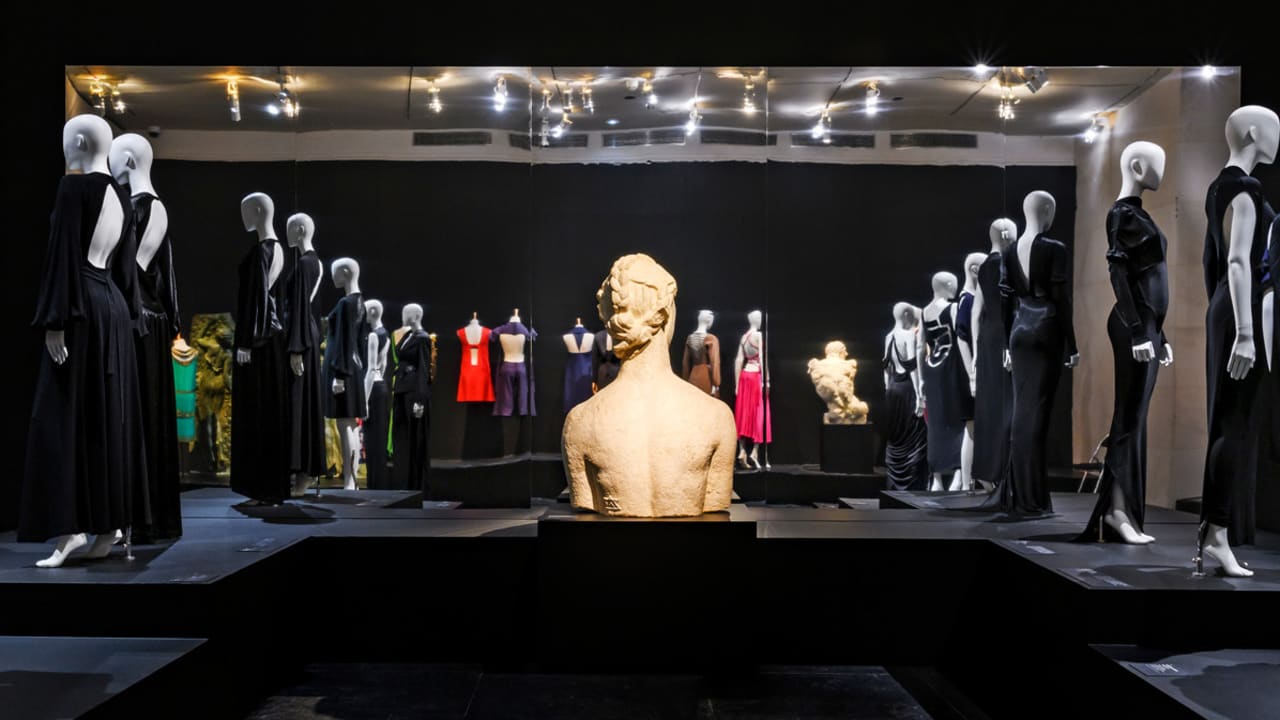The fashion industry is secretly obsessed with your backside - 5 minutes read
 Dos a la Mode exhibit shows fashion's obsession with backsides
Dos a la Mode exhibit shows fashion's obsession with backsidesAt a fashion show, models file down the catwalk one at a time, as the audience and photographers eagerly take in the designer’s aesthetic for the season. By the time the models spin around and walk the other way, turning their backs to the onlookers, many people stop paying attention to them. But canny observers will notice each fold of the bustle on a gown or how the back of a blouse is cut just so, revealing the curves of shoulder blades.
A new exhibit called “Dos à la Mode” at Musée Bourdelle in Paris exclusively features the rear-end of garments from various points in fashion history. Jean-Julien Simonot, the exhibition designer, decided to present the garments among enormous stone sculptures of nudes, many made in the late 1800s by sculptor Antoine Bourdelle, the museum’s namesake, to visualize the creative ways designers have interpreted our backsides over the years (and to present Bourdelle’s work in a new light). The exhibit is a fascinating glimpse at how our posteriors have throughout history had just as much expressive potential as the rest of our bodies—if not more.
Alexandre Samson, the director of haute couture at the Fashion Museum of Paris—Musée Bourdelle’s sister museum—selected an array of outfits that accentuate the back in different ways. Our backsides have often inspired designers’ taste for drama. Take red carpet gowns and wedding dresses: from the middle of the 20th century onward, they’ve often been designed with long trains that allow designers to play with folds of fabric or create elaborate embroidered patterns. One Balenciaga gown from 1961 is made of orange silk, which drapes down the back in large swaths. A famous 1984 dress by Thierry Mugler has wings on the back, like an angel.
But in some ways, the subtler backs are more intriguing. They are less about highlighting the designer’s prowess than highlighting the delicate complexity of the human back. One hall of the exhibit features dresses from the 19th and 20th centuries that highlight “naked backs,” which drape all the way from the neck to the bottom of a woman’s spine. The design calls to mind classical Greek robes, but it has been popular at many points in history, including during the flapper era and 1950s Hollywood. One 1997 creation from Martine Sitbon features a long-sleeved black dress with three diagonal cutouts in the back. It draws attention to the wearer’s shoulder blades, hinting at the sensuality of a woman’s back.
The back has also been a site of pathology—a fact some designers have tried to subvert. One part of the exhibit features straightjackets used in mental hospitals during the mid-20th century, complete with complex leather ties on the back. Here, the bindings in the back are functional, not decorative. But in the exhibit, they are placed next to Jean Paul Gaultier’s corseted shirt from 2003, which features delicate lace patterns as well as ties on the back that seem directly inspired by the straightjackets.
Of course, some designers attempt to speak plainly with the backs of their outfits. The back is the flattest part of our bodies, so it is easy for designers to emblazon it with words or phrases. One piece on display is the green $39 Zara jacket that Melania Trump wore as she walked toward Air Force One in June 2018 to visit immigrant children at the detention center. It had the words “I really don’t care, do u?” scrawled on the back, like graffiti. For weeks fashion critics speculated about what she meant by it, until she finally explained that it was meant to be a jab at the “left-wing media.”
It was a perfect example of how the backs of our garments allow us to express ourselves just as much as the front. The “Dos à la Mode” exhibit invites us to take a second look at the backs of our clothes and consider what they say about us.
Source: Fastcompany.com
Powered by NewsAPI.org
Keywords:
Calvin Klein • Fashion show • Model (person) • Runway (fashion) • Time (magazine) • Photography • Bustle • Blouse • Musée Bourdelle • Paris • Exhibition designer • Sculpture • Nudity • Sculpture • Antoine Bourdelle • Museum • Creativity • Work of art • Haute couture • Fashion Museum, Bath • Paris • Musée Bourdelle • Fashion design • Red carpet fashion • Wedding dress • Train (clothing) • Fashion design • Textile • Embroidery • Pattern (sewing) • Balenciaga • Gown • Silk • Dress • Thierry Mugler • Fashion design • Human back • Art • Ancient Greece • Robe • Popular culture • Flapper • Cinema of the United States • Martine Sitbon • Pathology • Leather • Beauty • Jean-Paul Gaultier • Shirt • Lace • One Piece • Zara (retailer) • Melania Trump • Air Force One • Really Don't Care • Graffiti • Left-wing politics •